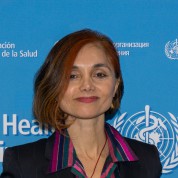PS 3.2
Transforming the Economy for Health Equity and Environmental Sustainability
29
Jan
The direct and indirect relationship between economic activities, health outcomes (equitable or otherwise), and environmental sustainability (notably climate change, biodiversity loss, and pollution) are no longer in doubt. What remains contested is whether reforms to our conventional market (capitalist) economy can lead to a ‘green growth’ in which the world equitably achieves net zero-carbon by 2050; or if the excess consumption of natural goods inherent in profit-driven market economies poses a systemic threat to the environment and, by implication, human health.
Some of the long- and medium-term financing and economic challenges that we face include:
- Unsustainable material consumption levels globally by high-income countries and the world’s richest 10%.
- The need for material consumption levels to rise in low-income countries and the world’s poorest 50% (generally through increased equitably distributed models of economic growth) to allow for ethical life expectancies.
- The pandemic and the invasion of Ukraine are increasing extreme (and not so extreme) poverty, food insecurity/acute hunger, and health inequities. The need for substantial financing for mitigation efforts directed to low-and-middle-income countries (LMICs) is greater now than in the years following the 2008 financial crisis.
- The economic shock from the pandemic and prospects for many LMICs of not recovering to pre-pandemic economic levels before 2026 have increased indebtedness, with recent inflation constraining their ability to fund access to essential health services and invest in green recovery.
- There is also concern that we may be poised for new rounds of austerity (fiscal contraction), and that new conditional lending to LMICs for pandemic relief and debt restructuring purposes will further weaken their ability to deal with the economic, health, and environmental fallout of COVID and the war in Ukraine.
Policy challenges include:
- HICs have yet to pledge and/or fulfill the level of commitments required to minimize the severe economic and environmental health risks now facing many of the world’s poorer populations. Instead, increasing emphasis is given to incentivizing private capital investment in climate change initiatives (green energy, mitigation efforts) and health systems strengthening. It is important to note that the social impact of green technology investing (if effective) addresses wealth inequities that arise by dent of who benefits financially from such investment.
- The pursuit of carbon-neutrality in areas such as national economies and international trade (e.g. through fiscal and taxation policies, carbon-border adjustment measures, and other trade or investment treaty revisions to account for a zero-carbon global economy by 2050) is important; but it must also be aligned carefully with social and health equity goals.
- Carbon taxation and removal of fossil fuel subsidies should be enhanced and defined as also delivering direct health benefits from reduced pollution while also increasing governments’ fiscal space to invest in health and green recovery.
- There need to be more financial institutional commitments to reduce loans to fossil fuel industries or redirect loans to green energy. Efforts to close tax havens (though improving) are still inadequate, while the commitment of many countries to ensure a minimum level of corporate taxation has yet to be implemented and fails to account for equitable allocation of tax benefits.
- Radical progressive and redistributive tax reforms (at national and global/intergovernmental levels) are needed to prevent financing shortfalls that risk sovereign debt defaults by LICs forced to borrow on global financial markets. IMF increases in special drawing rights holds some potential to reduce sovereign debt defaults but need to be adjusted to avoid most of the SDR benefits going to HICs and upper-MICs and not to LICs and LDCs where new financing needs are greatest.
- The financialized economy that led to the 2008 global financial crisis was spared dissolution through quantitative easing, which was repeated in central bank policies in most HICs in response to the social and economic dislocations arising from COVID and its public health interventions. In the years following the 2008 crisis little substantive reform to the liberalized global financial economy was undertaken, the result being vast amounts of surplus capital incentivizing private speculative investments and creating asset bubbles. This led to a huge upwards distribution in income and wealth, with most going to a sliver of elites. Governments must adopt policies that ‘tame global finance’.
- Supply chain disruptions, pandemic-induced savings, and a surge in post-lockdown demand are creating inflation and the real risk of stagflation. Corporate profits are increasing in many economic sectors, suggesting that profiteering may also be driving inflation and the need for windfall taxes.
- The corporate oligopoly in global food markets worsens the growing evidence of new famines and starvation, as food prices rise beyond the affordability of many of the world’s majority poor. Mass population movements within and between countries have not ceased, nor have the xenophobic responses and militarized borders by nations experiencing ongoing and often increased levels of irregular migration.
The intersecting nature of these crises suggests the need for new forms of economic management tools to achieve the net-zero target and a decarbonized economy by 2050 and to do so in a way that preserves biodiversity and avoids further environmental pollution. Such tools (intergovernmental agreements, policies, regulations, practices) must also be driven by the goal of reallocating the pre- and redistribution of material resources (and income/capital) within and between countries, while simultaneously reducing unsustainable levels of consumption by wealthier populations and countries and creating necessary consumption (growth) space for poorer groups and nations to achieve ethical life expectancies.
- Identify key tenets of economic ‘health for all’ policies that simultaneously decrease material (income/wealth) inequalities and achieve a safe consumption space protecting both human and planetary health.
- Debate the green growth/postgrowth (fair growth) policies in terms of improving health equity and ecosystem system sustainability at local, national, and global scales.
- Describe new financing mechanisms (fiscal policies, national/global funding programs, lending conditionalities) relative to achieving health equity and climate change goals and targets.
- Identify alternative economic and fiscal policies to austerity to reduce the impacts of inflation/profiteering and recession on health and human development outcomes.
- Discuss best practices in progressive (redistributive and environmentally protective) tax policies and strategies to overcome barriers to their implementation at local, national, and global scales.
Biosketch
Bridget Lloyd
Hani Serag
Jayati Ghosh
Ravi Duggal
Ritu Sadana
Ronald Labonté
Sandrine Dixson-Declève
Toomas Palu









